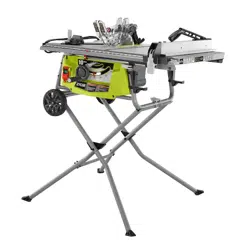Loading ...
Loading ...
Loading ...

28 - English
JIG
HANDLE
STOP
Fig. 32
3/4 in.
3-1/2 in.
21 in.
JIG
OPERATION
Fig. 33
WORKPIECE SUPPORTS
See Figure 31.
When cutting with your table saw, make sure that the
workpiece you are cutting is properly supported. Properly
supporting the workpiece throughout the cutting process
not only improves the accuracy of the cut but also makes
the cutting process safer for the user. This support could be
required on the infeed side, the overhang side, or the outfeed
side of the table. Improper support of the workpiece can
cause the workpiece to move in unexpected ways during the
process of the cut startling the user of the saw. It may also
cause the user to apply abnormal forces to the workpiece
to control it during the cutting process. This tipping motion
of the workpiece will happen if approximately half of the
workpiece overhangs any edge of the saw table.
Appropriate support can be easy to achieve. Commercially
available support stands are available, or any surface that
is the same height as the work surface of the saw would be
acceptable. An operation that is practiced before actually
making the cut will inform the user that supports may be
necessary for safely completing the saw cut.
AUXILIARY FENCE
An auxiliary fence is a device used to close the gap between
the rip fence and the saw table. Always make and use and
auxiliary fence when ripping material 1/8 in. or thinner.
HOW TO MAKE AND ATTACH AN AUXILIARY
FENCE (FOR RIP CUTTING THIN
WORKPIECE)
See Figure 32.
An auxiliary fence may be made for the saw by cutting a
piece of wood to 21 in. long, at least 3/4 in. thick, and at
least 3-1/2 in. tall.
NOTE: The height and thickness of the auxiliary fence can be
increased depending on the size and type of workpiece you
are attempting to cut. Use taller auxiliary fences when cutting
workpieces that are taller than the height of the rip fence.
To attach the auxiliary fence to the rip fence:
Place the wood against the left side of the rip fence and
resting firmly on the saw table.
From the back side of the rip fence, secure the wood to
the fence using wood screws.
NOTE: Make sure the screws you use to attach the
auxiliary fence do not pass through the front face of the
fence.
HOW TO MAKE A JIG (FOR RIP CUTTING
NARROW WORKPIECE)
See Figure 33.
If ripping a narrow workpiece places the hands too close to
the blade, it will be necessary to make and use a jig.
To make a jig:
Attach a handle to a long, straight piece of wood and
secure from the underside using recessed screws.
Cut an L-shaped stop in the side of the jig.
WORK
SUPPORT
Fig. 31
Loading ...
Loading ...
Loading ...
